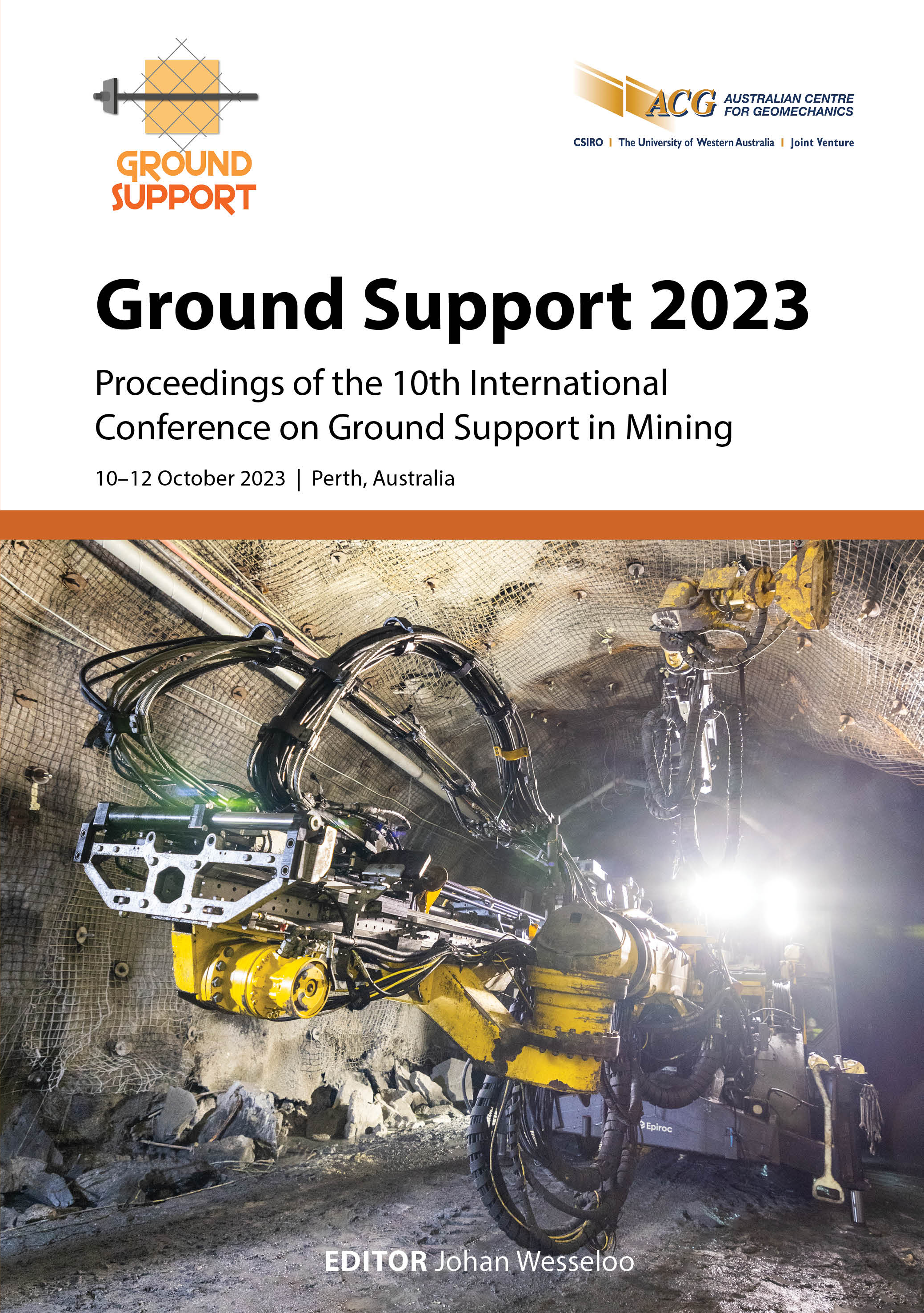Performance in shear of mechanical hybrid rockbolts

|
Authors: Knox, G; Hadjigeorgiou, J |
DOI https://doi.org/10.36487/ACG_repo/2325_33
Cite As:
Knox, G & Hadjigeorgiou, J 2023, 'Performance in shear of mechanical hybrid rockbolts', in J Wesseloo (ed.), Ground Support 2023: Proceedings of the 10th International Conference on Ground Support in Mining, Australian Centre for Geomechanics, Perth, pp. 495-506, https://doi.org/10.36487/ACG_repo/2325_33
Abstract:
The performance of a rock reinforcement system is a function of successfully matching a rockbolt to ground conditions and the quality of installation. In very heavily fractured ground, the installation of resin or cementitious grouted rockbolts can be challenging. This is due to resin losses within the fractures and voids surrounding the borehole, as well as ‘blown out’ holes and hole closures. Poor installation can result in quality issues which may prevent a ground support system from achieving its specified performance requirements. In adverse ground conditions, where it is difficult to install grouted rockbolts, a mechanical hybrid rockbolt may provide an alternative. The typical configuration of a mechanical hybrid rockbolt is a steel tendon mechanically anchored within a friction rock stabiliser. The rockbolt is installed using a percussion force applied by the rockdrill, and the mechanical anchor is subsequently activated using rotation. This installation process improves the rockbolt’s resilience to hole closures. The absence of a chemical anchoring medium in this configuration reduces the impact of fractures and voids on the performance of the rockbolt. Recent work has focused on quantifying the performance of a mechanical hybrid rockbolt when subjected to a pull or impact test. These investigations employed testing configurations where the loading was applied to the thread of the tendon, or the plate affixed to the tendon. Scant information is available on the performance of mechanical hybrid rockbolts when the rockbolt is subjected to either an axial or shear indirect loading case, which are common in fractured rock masses. This paper describes the methodology and the results of an investigation into the performance of the mechanical hybrid rockbolt when subjected to indirect axial pull testing and shear loading. The investigation was conducted under laboratory-controlled conditions and resulted in consistent and repeatable results.
Keywords: shear testing, mechanical hybrid rockbolt, laboratory conditions
References:
Andrews, PG 2019, ‘Ground support selection rationale: a Gold Fields perspective’, in J Hadjigeorgiou & M Hudyma (eds), Ground Support 2019: Proceedings of the Ninth International Symposium on Ground Support in Mining and Underground Construction, Australian Centre for Geomechanics, Perth, pp. 15–28,
_0.02_Andrews
Bray, P, Johnsson, A & Schunnesson, H 2019, ‘Rock reinforcement solutions case study: Malmberget iron ore mine, Sweden’,
in W Joughin (ed.), Deep Mining 2019: Proceedings of the Ninth International Conference on Deep and High Stress Mining, The Southern African Institute of Mining and Metallurgy, Johannesburg, pp. 191–204,
/1952_15_Bray
Chen, Y & Li, C 2014, ‘Performance of fully encapsulated rebar bolts and D-Bolts under combined pull-and-shear loading’, Tunnelling and Underground Space Technology, vol.45, pp. 99–106.
Darlington, B, Rataj, M, Balog, G & Barnett, D 2018, ‘Development of the MDX Bolt and in-situ dynamic testing at Telfer Gold Mine’, Rock Dynamics and Applications, CRC Press, Boca Raton.
Darlington, B, Rataj, M & Roach, W 2019, ‘A new method to evaluate dynamic bolts and the development of a new dynamic rock bolt’, in W Joughin (ed.), Deep Mining 2019: Proceedings of the Ninth International Conference on Deep and High Stress Mining, The Southern African Institute of Mining and Metallurgy, Johannesburg, pp. 205–216,
/ACG_rep/1952_16_Darlington
Hartmann, W & Hebblewhite, B 2003, ‘Understanding the performance of rock reinforcement elements under shear loading through laboratory testing - A 30 year history’, Proceedings of the 1st AGCM Conference.
Knox, G & Hadjigeorgiou, J 2023, ‘Performance of conventional and energy-absorbing self-drilling hollow core rock bolts under controlled laboratory conditions’, Rock Mech Rock Eng, vol. 56, pp. 4363–4378.
Roach, W, Rataj, M & Darlington, B 2019, ‘Development of a new Sandvik ‘little brother’ dynamic rockbolt and the in situ dynamic evaluation of bolts’, in J Hadjigeorgiou & M Hudyma (eds), Ground Support 2019: Proceedings of the Ninth International Symposium on Ground Support in Mining and Underground Construction, Australian Centre for Geomechanics, Perth, pp. 201–212,
Stacey, T 2012, ‘A philosophical view on the testing of rock support for rockburst conditions’, Journal of the Southern African Institute of Mining and Metallurgy, vol. 112, no. 8, pp. 1–8.
Stjern, G 1995, Practical Performance of Rock Bolts, PhD thesis, Norwegian University of Science and Technology, Trondheim.
Turcotte, P 2010, ‘Field behaviour of hybrid bolt at LaRonde Mine’, in M Van Sint Jan & Y Potvin (eds), Deep Mining 2010: Proceedings of the Fifth International Seminar on Deep and High Stress Mining, Australian Centre for Geomechanics, Perth, pp. 309–320,
Vallati, O, Darlington, B & Sandberg, L 2022, ‘Dynamic drop testing of Sandvik’s D47 and D39 MDX bolts at the Swerim’s testing facility’, Proceedings of The Fifth Australasian Ground Control in Mining Conference Proceedings, Australasian Institute of Mining and Metallurgy, Melbourne, pp. 428–440.
Watt, G, Roberts, T, & Faulkner, D 2018, ‘Single pass drill, install and inject self-drilling resin bolt applications in poor ground’, Proceedings of The Fourth Australasian Ground Control in Mining Conference Proceedings, Australasian Institute of Mining and Metallurgy, Melbourne, pp. 323–343.
© Copyright 2025, Australian Centre for Geomechanics (ACG), The University of Western Australia. All rights reserved.
View copyright/legal information
Please direct any queries or error reports to repository-acg@uwa.edu.au
View copyright/legal information
Please direct any queries or error reports to repository-acg@uwa.edu.au
